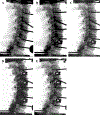Effectiveness of cervical zero profile integrated cage with and without supplemental posterior Interfacet stabilization
- PMID: 32585556
- PMCID: PMC7430527
- DOI: 10.1016/j.clinbiomech.2020.105078
Effectiveness of cervical zero profile integrated cage with and without supplemental posterior Interfacet stabilization
Abstract
Background: Conditions requiring cervical decompression and stabilization are commonly treated using anterior cervical discectomy and fusion using an anterior cage-plate construct. Anterior zero profile integrated cages are an alternative to a cage-plate construct, but literature suggests they may result in less motion reduction. Interfacet cages may improve integrated cage stability. This study evaluated the motion reduction of integrated cages with and without supplemental interfacet fixation. Motion reduction of integrated cages were also compared to published cage-plate results.
Methods: Seven cadaveric (C2-T1) spines were tested in flexion-extension, lateral bending, and rotation. Specimens were tested: 1) intact, 2) C6-C7 integrated cage, 3) C6-C7 integrated cage + interfacet cages, 4) additional integrated cages at C3-C4 and C4-C5, 5) C3-C4, C4-C5 and C6-C7 integrated cages + interfacet cages. Motion, lordosis, disc and neuroforaminal height were assessed.
Findings: Integrated cage at C6-C7 decreased flexion-extension by 37% (P = .06) and C3-C5 by 54% (P < .01). Integrated + interfacet cages decreased motion by 89% and 86% compared to intact (P < .05). Integrated cages increased lordosis at C4-C5 and C6-C7 (P < .01). Integrated + interfacet cages returned C3-C5 lordosis to intact values, while C6-C7 remained more lordotic (P = .02). Compared to intact, neuroforaminal height increased after integrated cages at C3-C5 (P ≤ .01) and at all levels after interfacet cages (P < .01).
Interpretation: Anterior integrated cages provides less stability than traditional cage-plate constructs while supplemental interfacet cages improve stabilization. Integrated cages provide more lordosis at caudal levels and increase neuroforaminal height more at cranial levels. After interfacet cages, posterior disc height and neuroforaminal height increased more at the caudal segments.
Keywords: Cervical cage; Cervical spine; Integrated fusion; Interfacet fusion; Posterior fusion; Supplemental fixation.
Published by Elsevier Ltd.
Conflict of interest statement
Declaration of Competing Interest The authors do not have a financial relationship with the industry research sponsor. The first and last authors have full control of all data.
Figures


Similar articles
-
Biomechanical comparison of a two-level anterior discectomy and a one-level corpectomy, combined with fusion and anterior plate reconstruction in the cervical spine.Clin Biomech (Bristol). 2014 Jan;29(1):21-5. doi: 10.1016/j.clinbiomech.2013.10.016. Epub 2013 Oct 30. Clin Biomech (Bristol). 2014. PMID: 24239024
-
Biomechanical comparison of single- and two-level cervical arthroplasty versus arthrodesis: effect on adjacent-level spinal kinematics.Spine J. 2010 Apr;10(4):341-9. doi: 10.1016/j.spinee.2010.01.006. Spine J. 2010. PMID: 20362252
-
Biomechanics of an integrated interbody device versus ACDF anterior locking plate in a single-level cervical spine fusion construct.Spine J. 2014 Jan;14(1):128-36. doi: 10.1016/j.spinee.2013.06.088. Epub 2013 Nov 12. Spine J. 2014. PMID: 24231054
-
Tissue-Sparing Posterior Cervical Fusion With Interfacet Cages: A Systematic Review of the Literature.Global Spine J. 2020 Apr;10(2):230-236. doi: 10.1177/2192568219837145. Epub 2019 Mar 25. Global Spine J. 2020. PMID: 32206522 Free PMC article. Review.
-
The Smith-Robinson Approach to the Subaxial Cervical Spine: A Stepwise Microsurgical Technique Using Volumetric Models From Anatomic Dissections.Oper Neurosurg. 2020 Dec 15;20(1):83-90. doi: 10.1093/ons/opaa265. Oper Neurosurg. 2020. PMID: 32864701 Review.
Cited by
-
Three-Level Anterior Cervical Discectomy and Fusion With or Without an Investigational Posterior Stabilization System Assessed Through 24 Months: A Multicenter Randomized Controlled Trial.Spine (Phila Pa 1976). 2025 Sep 1;50(17):1161-1170. doi: 10.1097/BRS.0000000000005387. Epub 2025 May 7. Spine (Phila Pa 1976). 2025. PMID: 40331720 Free PMC article. Clinical Trial.
References
-
- Fraser J and Härtl R, “Anterior approaches to fusion of the cervical spine: a metaanalysis of fusion rates,” J Neurosurg Spine, vol. 6, no. 4, pp. 298–303, 2007. - PubMed
-
- Veeravagu A, Cole T, Jiang B and Ratliff J, “Revision rates and complication incidence in single- and multilevel anterior cervical discectomy and fusion procedures: an administrative database study,” Spine J, vol. 14, no. 7, pp. 1125–31, 2014. - PubMed
-
- Fountas K, Kapsalaki E, Nikolakakos L, Smisson H, Johnston K, Grigorian A, Lee G and Robinson J, “Anterior Cervical Discectomy and Fusion Associated Complications,” Spine, vol. 32, no. 21, pp. 2310-17, 207. - PubMed
-
- McAffee P, Cappuccino A, Cunningham B, Devine J, Phillips F, Regan J, Albert T and Ahrens J, “Lower incidence of dysphagia with cervical arthroplasty compared with ACDF in a prospective randomized clinical trial,” J Spinal Disord Tech, vol. 23, no. 1, pp. 1–8, 2010. - PubMed
Publication types
MeSH terms
Grants and funding
LinkOut - more resources
Full Text Sources
Medical
Miscellaneous

